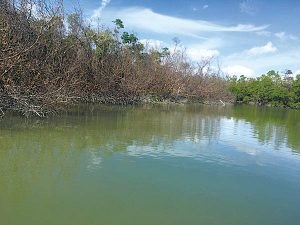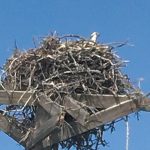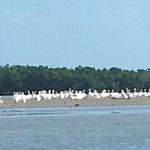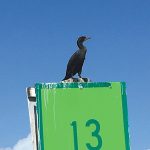February 5, 2020
Ten Thousand Islands
 By Mary Schricker Gemberling
By Mary Schricker Gemberling
“By protecting our oceans, we are preserving them for the next generation to enjoy.”…………………….. Author Unknown
Gary and I are spending the month of January in a somewhat obscure spot in Florida. At the southernmost end of Naples, Florida, just two miles before the bridge to Marco Island, lies the community of Isles of Capris. It is actually a grouping of four mangrove islands developed and connected in the 1950’s. Known for its boating and fishing, the community lies within the Rookery Bay Preserve. The preserve protects 110,000 acres of coastal lands and waters at the northern end of the Ten Thousand Islands off the gulf coast of Florida. The isles are surrounded by shallow saltwater bays, home to a variety of fish, manatees and bottlenose dolphins and are an integral part of the Ten Thousand Islands.
 In our quest to learn more about the Ten Thousand Islands Gary and I decided to take one of the many tours offered in the area. On a warm, sunny day we drove to nearby Goodland, a rather rustic fishing village, where we joined ten other people on an Eco- Endeavors tour. Captain Dave commandeered our boat along with his assistant Colt. After the routine narrative about safety and the expectations for the next three hours, the captain gave us a bit of background information on the islands.
In our quest to learn more about the Ten Thousand Islands Gary and I decided to take one of the many tours offered in the area. On a warm, sunny day we drove to nearby Goodland, a rather rustic fishing village, where we joined ten other people on an Eco- Endeavors tour. Captain Dave commandeered our boat along with his assistant Colt. After the routine narrative about safety and the expectations for the next three hours, the captain gave us a bit of background information on the islands.
The Ten Thousand Islands stretch along the Gulf coast from Lostman’s River, in the northwestern section of Everglades National Park, to Marco Island, the northernmost isle. Most are uninhabited except by the 200 bird species, 30 kinds of mammals, and 30 species of reptiles. The islands are comprised of over 230 square miles of mangrove forest, making Southwest Florida home to the world’s largest mangrove system. Three different species of mangroves found in the refuge provide unique habitat for aquatic and terrestrial plants and animals. It is estimated that 75% of game fish and 90% of commercial fish species in South Florida depend on the mangrove system. Mangrove systems provide sheltered and nutrient-rich nursery grounds for young fish, crustaceans, and mollusks. Clams, shrimp, and many fish feed in the mangrove forests and live among the complex root systems. Roosts and rookeries for coastal and wading birds are also made available by the intricate branches of mangroves.
As we slowly meandered through the mangroves we were able to spot a few of these birds: a double-breasted cormorant, an osprey, a snowy egret and an entire flock numbered in the thousands of white pelicans. What a rare sight to behold!
As our boat veered away from the vegetation and out into the open water, Captain Dave told us we were heading out to see the famed dome house. The home was originally built on Morgan Island, but erosion to the barrier islands has resulted in the home sitting out in the water with the closet island being Cape Romano, hence the name “Cape Romano Dome House”. The home was originally built as a vacation home for Bob Lee, his wife, Margaret and their children. The 2400 square foot house consisted of six interconnected dome structures. Rain water and dew would run into a 23,000 gallon cistern under the center dome, and provide all the water the family needed. Solar panels with backup generators provided heat and lighting. The home was both a vacation home and full time residence for the Lee family. After hurricane damage rendered the home uninhabitable, the family abandoned it in 1992.
After our photo ops of this unusual site in the middle of the Gulf were complete, we headed full throttle out into the open water. Our next stop was on the shores of Cape Romano Island to do a bit of shelling. Since I always bring back a wide array of unusual shells for my granddaughters, I was excited to see what treasures I could find. Our captain explained that the tides had been particularly low due to the full moon, and since we arrived shortly after a low tide, we should expect to see more unbroken and varied shells. I am no expert on shells and do not often know what I am picking up, but I felt I had hit pay dirt. There were so many unusual shells in varied colors, that I can’t wait to share my stash with Pearl and Lucy when I arrive home in March!
It was time to head back to Goodland, but little did we know we were in for another surprise. Dolphins, dolphins and more dolphins were swimming beside our boat, jumping gracefully through the air as if auditioning for Sea World. At one time there must have been at least a dozen of the graceful mammals around our boat. What a sight to see!
As our boat trip came to an end and we arrived back at the dock, it was the unanimous opinion of all on board that the Echo-Endeavors’ crew had done a very thorough job of not only educating us about the islands but showing us first hand a nice sampling of the inhabitants who call the echo system home.
“Being out there in the ocean, God’s creation, it’s like a gift He has given us to enjoy”…………………Author Unknown
Mary, a former educator and Seniors Real Estate Specialist is the author of three books, The West End Kid, Labor of Love; My Personal Journey through the World of Caregiving, and Hotel Blackhawk; A Century of Elegance.
Filed Under: Community, Featured, Personal Growth
Trackback URL: https://www.50pluslife.com/2020/02/05/ten-thousand-islands/trackback/





